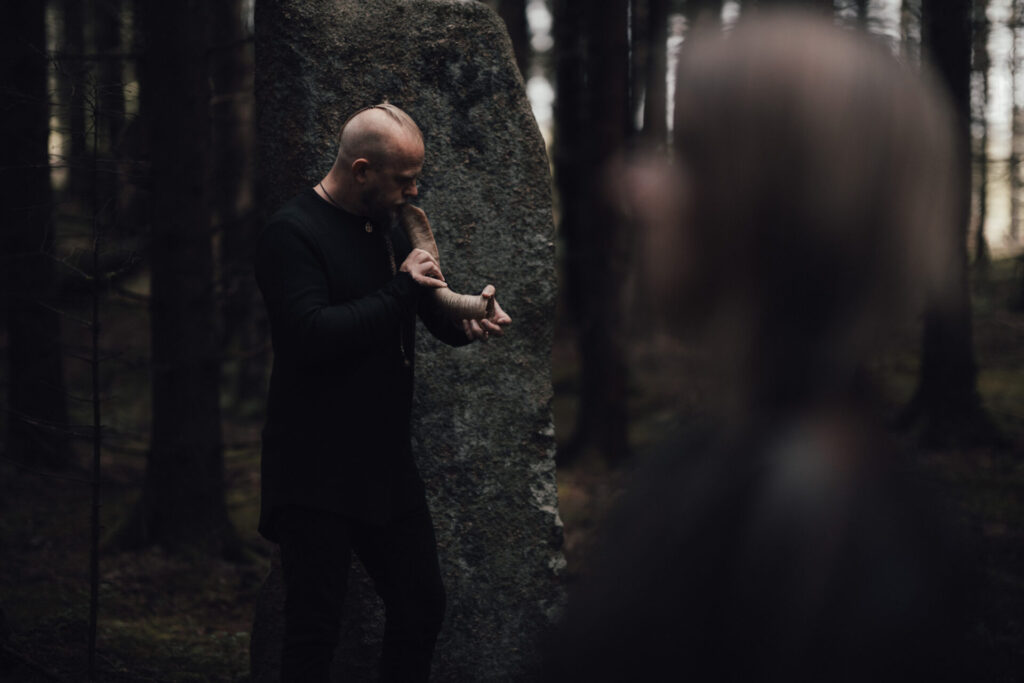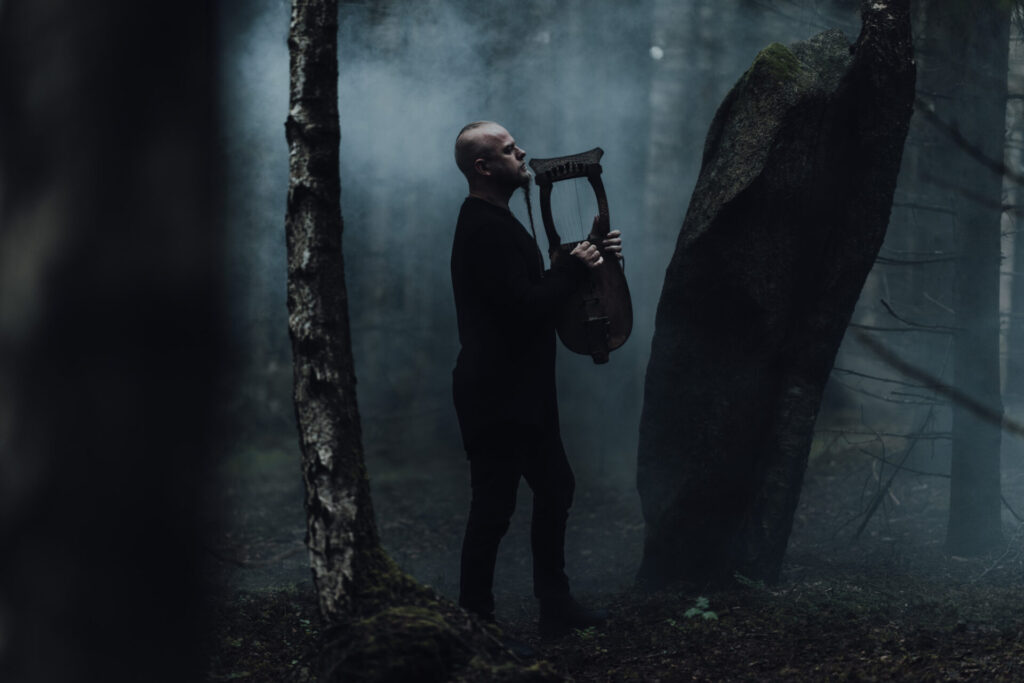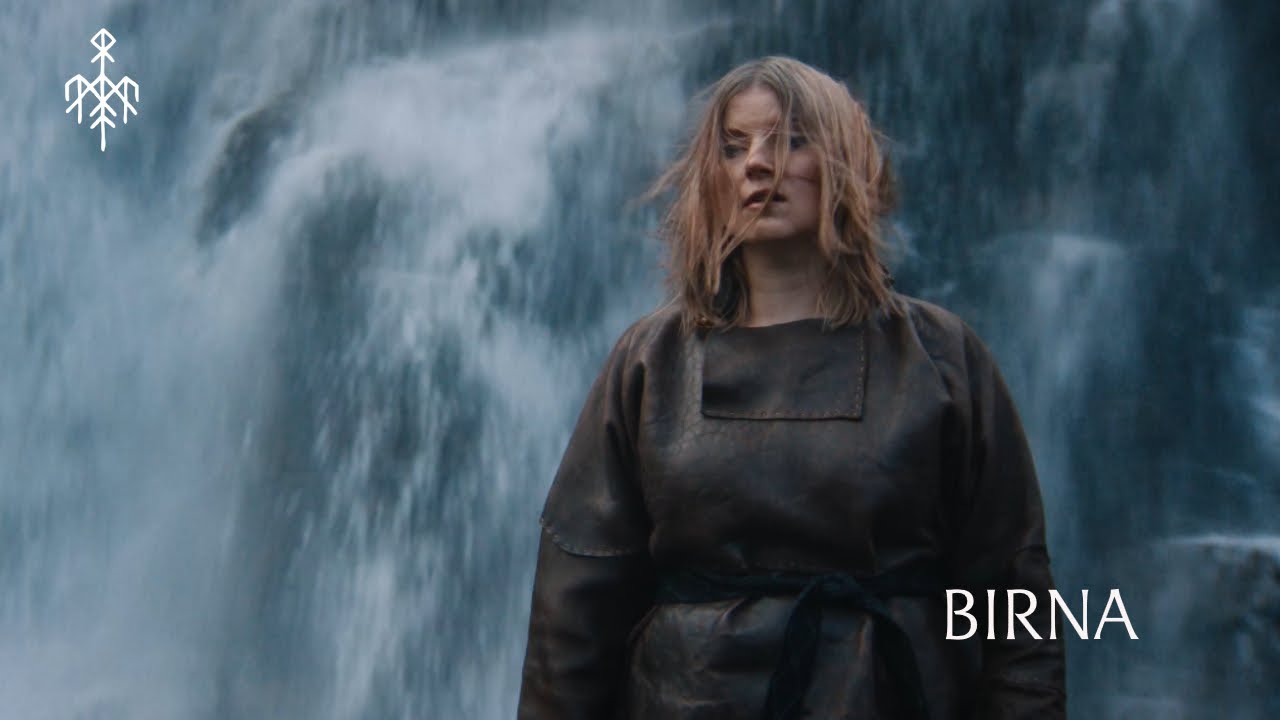Following the lofty flights of 2021 album Kvitravn (White Raven), Wardruna are returning to the heart of winter with new album, Birna (She-Bear). Central to Wardruna’s sound is Einar Selvik’s fascination with instruments from the past and their uncanny ability to describe the concerns of the present.
Wardruna’s music is shaped by its themes. Animism – the living soul of all nature – is a prevailing thread throughout, as well as Norse culture and much more. On Birna, the bear, the guardian of the forest, calls out to us. In the album’s 15-minute-long centrepiece, ‘Dvaledraumar’ (‘Dormant Dreams’), we are drawn into the bear’s winter hibernation as a low drum provides the steady pulse of its heart at nine beats per minute. Selvik plucks a three-note sequence of dreamy overtones on a Kantele lyre, native to Finland, and the Karelia region of Finland and Russia – bear country. The bear’s cave drips and strange, low, whale-like sounds provide the ambience (in fact, field recordings of singing ice captured in northern Norway). We are awoken from this meditation by willow flutes which Selvik made – cut from the tree before the leaves emerge and the bark is full of sap – announcing the arrival of spring and the bear’s awakening from its dreams.
Selvik tells me that the bear, the soul and conductor of this album, loves the sound of goat horns. But not longer-horned instruments, because historically they were used to scare off predators from mountainous farms. It’s clear talking to Selvik that these instruments are more than just an extension of himself and tools to create Wardruna’s sound world. They animate his very being, where “I become the instrument and the theme becomes the composer”.
Tradition on its own premises
“I think that since I was a child, it always resonated well with me whenever I heard certain parts of traditional music or songs, or certain parts of historical music. Then, as always, especially the more melancholic stuff. So that’s something that came about very early. The vision of doing Wardruna, or what became Wardruna, I can think back to when I was 15 or 16. I remember I could hear it in a way – hear the sound, or see it. I don’t know how to describe it, but it was clearly there. I think it was also created out of there not being a musical project out there that dealt with these themes and these traditions on their own premises.”
Trial and error: a lot of shitty instruments
“When I really started to go into it, the place was the history books. That’s where I came across most of them, because this was the early 2000s. There were a handful of people who knew about it – it was really obscure stuff. Across Scandinavia, there were a handful of people who were talking and using these actively. The internet wasn’t that big then, so you had to go to books. There were some musical publications – antiquarian, sort of ‘This is the instrument – pling plong’. Nobody was making music with it. Then talking to musical archeologists: I went to the museums to speak with the people there, get to see the original and then, in some cases [going further]. You couldn’t just order it online. So it was a lot of talking to instrument builders, getting people to build instruments for me, and in some cases, build it myself. It was a lot of trial and error. I made quite a lot of shitty instruments. Some miserable attempts, but also some good ones that I still use.”
Don’t climb rootless trees
“It’s never been a goal for me to recreate music from any specific time period. For me, it’s about taking something old and creating something new with it. But I don’t like climbing into trees that don’t have roots. I like to stand on solid ground before I go into any of the creative or intuitive processes. And that demands, of course, a lot of research into the ethnomusicology, which is something I think is very, very interesting. It’s detective work, in a way, and then you need to have a very broad overview of the sources, because it’s so fragmented.
“One thing is the limitations within the instruments. Some of the instruments are very limited. A lot of music archeologists, they talk a lot about how we can never know what music sounded like in the Viking age or whatever. I’m not sure I agree. I think if you combine what we know, have a broad overview and puzzle it together, there’s quite a lot we can say about the tonality. The wind instruments, the lurs [horns], the ancient forms, they are completely locked to the overtones scale, the harmonic scale – that’s the modern term. Some of the oldest bone instruments: they also have a very small window of what you can and cannot do. So almost whatever you do will be authentic, and they are drone-based as well, which means you have one string resonating on one tone only, and then you have a melody you play on top. It’s pretty limited. Also we have very good sources describing how the Germanic lyre was tuned, and that, again, resonates very well with other things we know from oral culture. So it’s a giant jigsaw.”
You’re bringing the animal back to life
“A lot of the drums have been with me and have traveled the world. When you build drums the old way, and especially the preparation of the hides when you use rawhide material, I think it’s quite a beautiful process. I use deer, because there is white-tailed deer where I grew up. There’s a lot of them there. I have a connection to them. I didn’t shoot the animal, but I did everything else. I was part of skinning, cleaning the hide. Then you go into this whole process of getting the hair off, because you don’t shave it – it’s more about killing the hair sacs. Tying the hide in the river for weeks, and then after that, it’s the long, tedious process of scraping: smelly, tedious. But the beautiful thing is that, at some point, you realize you’re bringing the animal back to life. And I like the poetry in this. This deer has traveled with me all over the world. Its lower leg bone has been the drumstick. Even her hooves have been shakers. I think it’s a very beautiful, poetic process to work with these nature instruments. They have so much more will of their own, in a way, so much more spirit in all senses of the word: personality.”
The instruments get grumpy if you don’t play them enough
“They’re so sensitive to their environment as well. So you never really know what you’re gonna get. Like the goat’s horn. When I pick one up, especially at outdoor concerts, I never know quite how it’s going to behave. That keeps you on your toes. Very often you play and they’ve been out there since it was daylight. And then when nightfall comes, the moisture and everything does something. Especially to nature instruments which are more alive, basically. So sometimes the pitch is completely different. Sometimes I pick up the goat horn, try to do some epic stuff, and end up sounding like a sick cow. There have been some slightly comical moments, but that’s how it is. And also they get grumpy. The horns I always have to play – at least one time before the show. If I don’t, they become grumpy and act out during the show. If I forget – it’s payback time.”

Nature creates culture
“It’s important that my artistic decisions are very often based on things we know or think we know about history and its music. For me, the output is very modern.The soundscape is very modern, it’s because I live here and now, and it’s for me to be pleased. It needs to sound like this, and that’s why it connects to people here and now as well, and the same goes for the thematics. There are so many things from these old traditions that belong in the past, rightfully, because they have no place. They have no natural place here. They have no relevance anymore. But the thing with a lot of these nature-based traditions is that nature creates culture wherever it is. The culture is shaped by nature, and that is why so many of the things from the nature-based traditions still resonate with us. And of course, in a society where the void between us and our surroundings is just becoming bigger and bigger. We are more and more sick. We are more and more lost. I think people find our music to be a bridge, to connect a place and space, to connect to our environment. I know a lot of people think my music is about Vikings and swords and shit. The Vikings show used our music. I was part of that, but that has nothing to do with the thematics of our songs. It has always been a very animistic place and force. But perhaps on the last two albums, I’ve become less esoteric and more direct in my way of voicing that.”
Speaking to people on a global scale
“Even though the packaging is Nordic on our music, the fact is, when you go back in time, you see just how similar it is. The same instrument types. It’s very often the same tonalities. It’s the same polyrhythmics. You always find the fifth – the fifth note – all over the planet. And that’s the same with all of these folklores – the deities’ connection to nature. The similarities are much more prominent than the dissimilarities. That is also why I think it speaks to people on a global scale. It’s so ancient and universal that it is almost in our DNA. You find it everywhere. It makes more sense that it’s a dialect of the same thing, and that fits with the idea of nature creating culture – the dialects. Because nature is different in Norway than it is in South America, but the mechanism of creation is the same.”
Paganism has different needs now
“There is no escapism in what we do. I don’t romanticise the past. There was just as much stupidity back then as there has always been. And also, you have to remember that animism now, or paganism now, is completely different than it was then, because it has different needs. They did not have a romantic idea about nature. They fought nature. It was the cultivated crop fields that were their sacred earth. The ones they used to heal sick children. It was wild nature that was dangerous. That’s where the trolls and bad spirits and everything bad were. The giants, they call them in English, represent everything that’s not cultivated and tamed.
“Today, it’s the complete opposite. But of course, it’s that need to tame the world that brought us here in the first place. So you can’t just go back in time – it doesn’t make any sense. It’s completely different. You can’t recreate their way of doing it because their way was based on completely different means. And if you don’t consider the needs in your ritual practice, or in your way of believing, it has no function, there is no potency in it. It’s hollow symbols. It’s hollow words. It’s hollow traditions. And unfortunately, a lot of what you see in that [nativist] movement is just that, because the premise is wrong and now it’s changed.
“That is why I say that some things belong in the past: something we learn from and we move on. I don’t idolize what they were doing 2,000 years ago, because I think that by learning what they did, we can do it so much better now. That’s the power of history. That’s what it’s there for: memory. History is the healthy relation to your roots. That’s what is there to secure you to your shoes. Then you don’t feel threatened by meeting other people who are strong in their roots and where they come from – quite the opposite. Then it becomes a healthy meeting. So I think that’s also a problem why people are so scared of that. They are rootless trees.”
Wardruna’s new album, Birna, is released 24th January via Music For Nations and By Norse Music.



